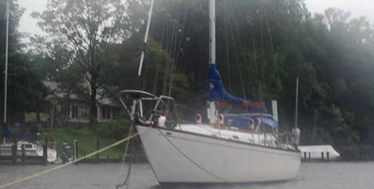It was 2300 Aug. 27, and Irene had arrived. Each gust shook the rig, heeled the boat, and caused the anchor rodes to groan. The gusts bore down at 60 knots, only half of what Hurricane Irene had doled out to those hunkered down in the Bahamas just a few days before. But even with a lot less torment than had been originally promised, I had my hands full with the conditions unfolding on what was usually a quiet estuary just off the Chesapeake Bay.
In response to the forecast fury, I had moved our Ericson 41, Wind Shadow, off the dock she normally occupies and anchored her in the well-protected arm off Whitehall Creek—an even more sheltered, dead-end creek. The gameplan was to implement a ride-it-out strategy I began refining in 1976, when cyclones Kim and Laurie pinned us down in Bora Bora, French Polynesia. Since then, my favored tactic has been based upon ground tackle overkill, a penchant for finding the best all-around protection, and the luxury of getting settled a day before the big event comes to town. The plan capitalizes on a simple oceanographic principle: little fetch equals little waves. And without waves, the challenge of staying put becomes a lot less onerous.
Every storm is different, and each anchorage holds its own set of challenges. One of my biggest concerns is always the hazards linked to overcrowding. Like extra shrapnel in a hand grenade, the threat from neighboring boats can be significant. An upwind vessel dragging anchor can easily become part of your ground tackle network, and even if the anchor-bound nexus holds, the prospect of an unwanted raft up never plays well in any kind of storm. Picking a well-protected but less populated hideaway pays off, and being the only anchored vessel in a well-protected creek gave me one less thing to worry about.
Setting anchors in anticipation of a tropical storm or hurricane is a little like making the first moves in a chess match—seemingly minor commitments can set the stage for success or lead to big troubles ahead. My challenge this time was setting up for a backing breeze that would fill in from the east and eventually become just as punishing during the storm’s departure, when the wind was likely to blow from the west.
The good news was that the storm would pass to the east of us, putting Wind Shadow in what’s euphemistically known as the navigable triangle. The worst wind and seas are always found in the righthand, forward facing “dangerous” quadrant of a hurricane. So my challenge was to set up with enough swinging room to endure the wind shift, in a creek that was almost too tight to do so. Any thought of bow-and-stern anchoring had to be dismissed due to the massive exposure endured when the wind would be on the beam. Instead, I set two opposing anchors and a line ashore, all leading to the bow so that the boat would act like a weather vane with each gust.
Riders on the Storm
Wind Shadow is a 10-ton, 41-foot sloop, and the ground tackle I used for the sand/mud bottom included her working anchor, a 45-pound plow with 10-millimeter BBB chain (150 feet deployed in 12 feet of water), plus a 60H Danforth on a ¾-inch, braided-nylon anchor rode. I chose not to use the 75-pound, three-piece Luke storm anchor tucked away in the bilge, instead using a floating ¾-inch “poly-dac” line secured to a stout bulkhead ashore. Tying ashore to docks or other structures usually requires an OK from the property owner. I tied one line ashore to the pilings and bulkhead of the slip I rent in 200-foot-wide Minnow Creek. In narrower waterways that aren’t surrounded by residential property, it may be possible to have multiple lines tied to shore strongholds. While this is always a good idea, it wasn’t possible in Minnow Creek.
What I hadn’t anticipated was the ferocity of the williwaw-like puffs spawned in the high-banked little creek. They proved the value of a chain rode that helped dampen the slingshot effect of the scouring gusts.
One of the reasons I left the dock was to be better able to cope with the storm surge and rising tide. Years before, I’d seen the results of storm-induced tidal surges when Hurricane Isabel submerged even the tops of dock pilings. This time, the storm’s arrival coincided with a new moon spring tide, and the weather gurus initially hyped the prospect for a massive tidal rise. Thanks to the fickle whims of Mother Nature, upper-level steering currents kept the eye of the weakening storm to the east of the Chesapeake Bay, and the surge-building southerly wind remained well out to sea.
Fortunately, Irene outwitted weather experts who had been forecasting a perilous surge destined to submerge the Northeast, and the hurricane will go down in the books as a nasty tropical storm, not a sequel to hurricanes Andrew, Katrina, Hugo or the hurricane of 1938, when Narragansett Bay took a direct hit.
In every storm I’ve ridden out aboard Wind Shadow, I’ve towed along a trusty rigid dinghy with 7-foot spruce oars. In a pinch, I can row the boat into 40-knot gusts and get an anchor to windward or a line ashore. But tropical weather comes with torrential rain, and bailing the boat becomes another part of the storm ritual. A handy 2½-gallon bucket is my tool of choice, but this time, the bucket had apparently fallen victim to UV degradation. Thankfully, I had a collection of trimmed-to-shape 1-gallon plastic containers to use as scoop bailers.
Another surprise occurred about 0300—a time when most snafus seem to arise on sailboats. In this case, the unrelenting northeast wind finally decided to back to the northwest, and something akin to what happens in the eye of a tropical storm occurred. The wind slackened, allowing Wind Shadow to execute a nifty pirouette around the three lines and the chain snubber deployed from her bow. Having learned the value of three cleats on the foredeck, I first shed the chain snubber, and then, one-by-one, I pulled each bitter end back around the chain and fair led it to a cleat. Being able to free each line and have a dedicated cleat to re-attach it to proved to be quite valuable, and by using the vessel’s yawing tendency, I was able to un-cleat and swap around each line when the load was minimal.
This was a good time to reaffirm the observations we made in our recent round of anti-chafe gear testing (PS, July 2011). I used Fjord’s Chafe Pro on the poly-dacron line that was led to shore, and it protected the line against abrasion caused by the turn taken on the bulkhead piling. My homemade, heavy leather anti-chafe protection nicely fit on the bow chocks (see more on this with the online version of this story), and I used the RodeRap sample Fiorentino sent PS for the chain snubber, which ran through the bow roller trough. All remained in place and showed only minor wear after the storm. It’s interesting to note that the 3-foot RodeRap I used was longer than the Fiorentino Line-Rap we tested for the July report, and it featured high-density closed cell foam, which improved the padding effect for the snubber line running alongside the anchor chain.
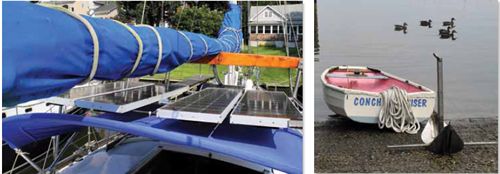
A snubber line can also be run through a separate bow chock, but because these were in use with other lines, padding and chafe-protecting the bow roller made most sense, and the Rode Rap did the job quite well.
Wind Shadow was not the only boat our family needed to get ready for the storm. Our sweet little Cape Dory 19 was moored in another harbor on a 150-pound mushroom with sturdy half-inch proof coil chain. The Cape Dory, Merlot, was stripped of sails and covers. To add a safety margin, I set a folding Northill anchor (designed to anchor seaplanes) on 12-to-1 scope. It was placed to the north, splitting the difference between the onset and departure wind direction. After setting the anchor, I eased off about 20 feet of extra scope so that all of the load would reside in the mooring tackle unless it parted or the little sloop began to drag, and I placed Taylor Made rubber chafe guards in each chock. These also held up well in the storm.
A friend with a boat in the marina where Merlot was moored watched her during the storm, and at the worst of the weather, she was pitching like a metronome, completely burying her bow in the gust. My plugging the single center-deck cowl vent proved to have been a good idea.
To Stay Or Go
During a tropical storm or hurricane, many sailors double-up on docklines, double-check their insurance policy, and double-time it home to stand watch in front of the Weather Channel. Although the logic of pre-storm preparation—reducing windage onboard and adding extra fendering and lines to keep the vessel in place—is uncontested among boat owners, the question of whether to stay on board during a storm continues to be a hot debate.
Risk mitigation experts tell us to avoid being onboard in bad weather, and they may even mandate leaving the house for higher ground. Legislating safety is all well and good, but it doesn’t help those cruisers or live-aboard sailors whose boats are more than a recreational whim. In such cases, the big question is whether you can enhance the survivability of your vessel by remaining on board, without putting yourself in too much danger.
Add to this the fact that if a sailor wants to develop seamanship skills, they need to do so incrementally, and for the relatively well-practiced intermediate sailor, riding out a gale or a tropical storm in a protected anchorage with superior ground tackle can be a valuable addition to their learning curve. Those with less interest in developing seamanship skills should steer clear of the challenge and follow the mainstream guidelines.
Don’t get me wrong, this is not a ride-the-wild-bronco test for thrill seekers. It’s a way to keep owner and vessel safe in heavy weather, and while it’s best to stay below during the peak of a storm, it’s not always possible. Riding out a storm in a fully-protected anchorage offers owners the chance to ease lines, replace chafe gear, avoid another dragging vessel, or clear downed trees and floating logs that have become entangled on an anchor rode. Should circumstances require you ondeck during heavy weather, protect your eyes from slashing rain and blowing debris by wearing a snorkel mask or goggles, have a boat hook (preferably solid wood) handy, wear an inflatable (manual) PFD with harness so you can clip in when possible, and beware of flying debris.
In short, having an active response plan can be more effective when it comes to storm survival than simply leaving a boat to fend for itself. The more exposed the mooring field or anchorage, the more dangerous the situation becomes, regardless of whether or not the crew is on board. In such situations, it makes most sense to double up on everything and head for high ground before the storm threatens both you and your boat.
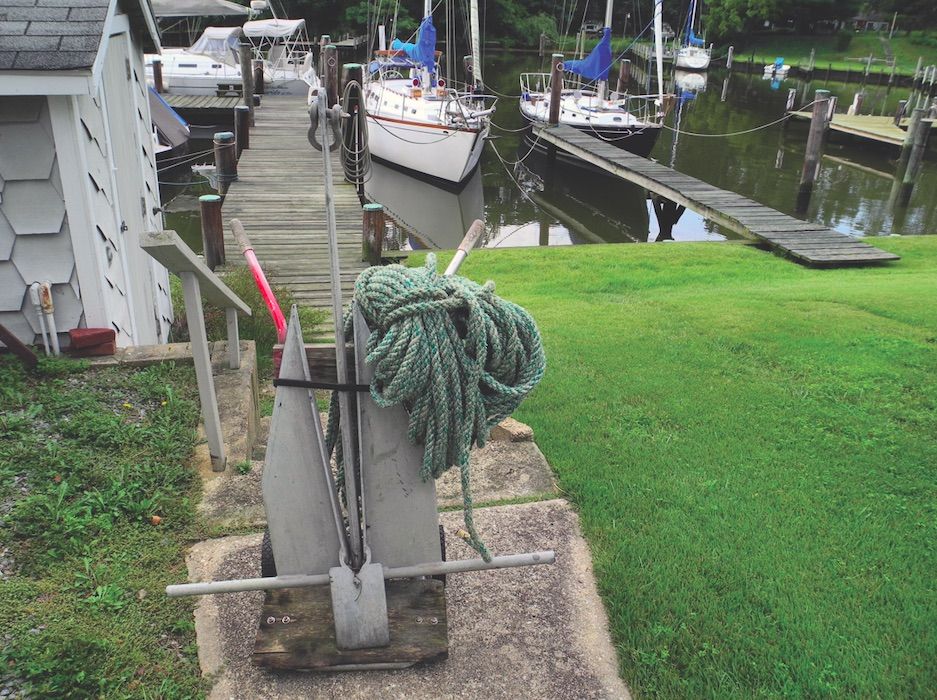
When tropical weather threatens, being prepared for the wind, waves, surge, and flooding pays off. How you prepare for a storm depends on where your boat is in relation to the storm and whether you choose to keep it at a dock, on a mooring, or anchored in sheltered waters or a hurricane hole.
Irene may have lacked super-storm status, but her sizable diameter and the angle with which she approached the Northeast coastline caused considerable impact from Beaufort, N.C., to Bangor, Maine. Sailors hiding from the storm faced a range of impacts. The most common was tropical-force winds with gusts to about 60 knots.
For those on the Chesapeake Bay, Irene passed to the east. The combination of encountering the favorable side of the storm—with the subtractive nature of its wind direction and forward movement reducing the apparent wind—and the minimal storm surge kept damage to docks and marinas to a minimum. Long Island and Connecticut, on the other hand, saw a more significant tidal rise, and those caught on the eastern side of the storm also had more wind to contend with. Marinas as far inland as Lake Champlain (in Vermont and New York) suffered serious damage as sailboats and finger piers lost their grip on the lake side. Rain was a big issue, and as small streams flooded, a plethora of debris and flotsam floated into coastal waters, creating prop-damaging hazards during the days following the storm.
Along the Chesapeake, we noticed that more owners of the marina-secured boats had stripped off furling headsails and bimini tops ahead of the storm’s arrival. Those left on moorings doubled-up on bridles and added secondary mooring pendants.
Quite a few sailboats were hauled out in preparation for the storm. Many owners did so as a result of the early forecasts that indicated Irene would make landfall as a Category 2 or 3 hurricane. The fact that it had weakened significantly just before and during initial contact with land changed the outcome. North Carolina bore the mainland brunt of the storm, and only one or two boats were caught out. A 30-foot sloop heading up the Chesapeake was driven ashore. What the crew had in their mind was an escape from the storm’s worst effect. Unfortunately, they were a day late in their departure and certainly should have stayed put.
Landfall in New England coincided with a new moon spring-tide, and shortscoped moorings in crowded mooring fields led to a number of dragging problems. Those on the eastern side of the storm saw more wind and surge while those on the western side ended up with considerably more rainfall.
Storm Readiness
If you plan to ride out a storm aboard, be sure the following are checked off your To Do List well ahead of the storm:
- Search out an uncrowded, protected anchorage with adequate swinging room.
- Strip off high-windage items like sails and biminis.
- Lash loose deck gear.
- Dorades ready to rotate sternward.
- Double-check that hatches and opening ports are dogged securely.
- Make sure your bilge pumps are reliable and are working properly.
- Have a bright LED anchor light.
- Load your ground-tackle arsenal with anchor overkill.
- Be sure you have plenty of fenders deployed and extras ready to deploy.
- Have these items at the ready: extra line, a waterproof head lamp, a sharp fixed-blade knife (on deck), a well-made bucket and backup bailers, good victuals, and a couple of good books.

While Technical Editor Ralph Naranjo was hunkered down for Hurricane Irene in Annapolis, Md., PS contributing editor Frank Lanier was worrying over his boat, a Union 36, which he secured at a floating marina dock at the other end of Chesapeake Bay. A short dockwalk revealed some good examples of fender and chafe guard do’s and don’ts.
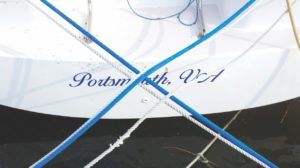 1. DON’T: Criss-crossing dock lines without chafe protection is a bad idea, especially during a hurricane.
1. DON’T: Criss-crossing dock lines without chafe protection is a bad idea, especially during a hurricane.
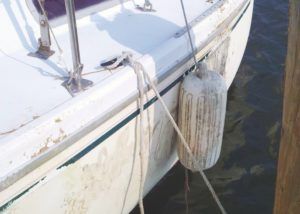 2. DON’T: A small, vertically hung fender did little to keep this boat from shaving the adjacent piling top to bottom. Note the wood shavings at the piling base and the peeled-back cap at its top, which is about 4 feet above normal water level.
2. DON’T: A small, vertically hung fender did little to keep this boat from shaving the adjacent piling top to bottom. Note the wood shavings at the piling base and the peeled-back cap at its top, which is about 4 feet above normal water level.
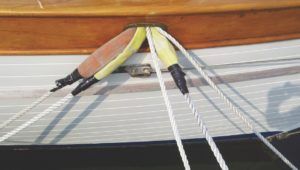 3. DO: Lanier doubled-up dock lines and taped chafe guards in place on his primary lines; there wasn’t enough space to add chafe gear for secondary lines.
3. DO: Lanier doubled-up dock lines and taped chafe guards in place on his primary lines; there wasn’t enough space to add chafe gear for secondary lines.
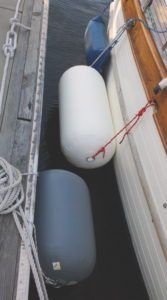 4. DO: Lanier used extra-large, horizontally hung fenders.
4. DO: Lanier used extra-large, horizontally hung fenders.
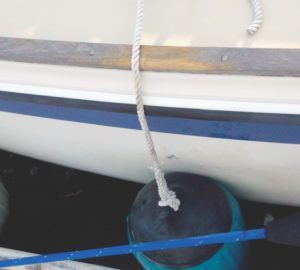 5. DON’T: Hung without chafe protection, this fender wore a groove in the boat’s teak toerail.
5. DON’T: Hung without chafe protection, this fender wore a groove in the boat’s teak toerail.


































